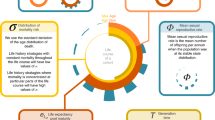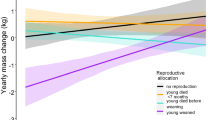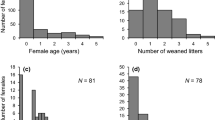Abstract
The disposable soma hypothesis posits a negative correlation between longevity and reproduction, presumably because these aspects of fitness compete for a limited pool of nutrients. However, diet, which varies widely among animals, could affect the availability of key nutrients required for both reproduction and longevity, especially protein. We used a comparative database of mammal life history data to test the hypothesis that carnivores experience less of a negative relationship between reproduction and longevity than herbivores. Annual reproduction and adult mass were significant predictors of longevity among all mammals; although, the relative importance of reproduction and mass for explaining longevity varied among trophic levels. In herbivores, reproduction was a stronger predictor of longevity than mass. Carnivores showed the opposite pattern with reproduction explaining much less of the variation in longevity. Omnivores showed an intermediate pattern with mass and reproduction explaining similar amounts of variation in longevity. In addition, longevity and reproduction were significantly higher in omnivores than herbivores and carnivores, which were not different from each other. Higher dietary protein at higher trophic levels may allow mammals to avoid potential conflicts between reproduction and longevity. However, there may be potential costs of carnivorous diets that limit the overall performance of carnivores and explain the peak in reproduction and longevity for omnivores.


Similar content being viewed by others
References
Alvers AL, Fishwick LK, Wood MS, Hu D, Chung HS, Dunn WA, Aris JP (2009) Autophagy and amino acid homeostasis are required for chronological longevity in Saccharomyces cerevisiae. Aging Cell 8:353–369
Austad SN (1997) Comparative aging and life histories in mammals. Exp Gerontol 32:23–38
Austad SN (2009) Comparative biology of aging. J Gerontol 64:199–201
Austad SN (2010) Methusaleh’s Zoo: how nature provides us with clues for extending human health span. J Comp Pathol 142:10–21
Austad SN, Fischer KE (1991) Mammalian aging, metabolism, and ecology: evidence from the bats and marsupials. J Gerontol 46:B47–B53
Cameron GN, Eshelman BD (1996) Growth and reproduction of hispid cotton rats (Sigmodon hispidus) in response to naturally occurring levels of dietary protein. J Mammal 77:220–231
Cichon M (1997) Evolution of longevity through optimal resource allocation. Proc Roy Soc Lond B Biol Sci 264:1383–1388
D’Antona G, Ragni M, Cardile A, Tedesco L, Dossena M, Bruttini F, Corsetti G, Bottinelli R, Carruba MO, Valerio A, Nisoli E (2010) Branched-chain amino acids supplementation promotes survival and supports cardiac and skeletal muscle mitochondrial biogenesis in middle-aged mice. Cell Metab 12:362–372
De Magalhães JP, Costa J (2009) A database of vertebrate longevity records and their relation to other life-history traits. J Evol Biol 22:1770–1774
Fanson BG, Weldon CW, Pérez-Staples D, Simpson SJ, Taylor PW (2009) Nutrients, not caloric restriction, extend lifespan in Queensland fruit flies (Bactrocera tryoni). Aging Cell 8:514–523
Grafen A (1989) The phylogenetic regression. Phil Trans Roy Soc Lond B Biol Sci 326:119–157
Harshman LG, Zera AJ (2007) The cost of reproduction: the devil in the details. Trends Ecol Evol 22:80–86
Kirkwood TBL (1977) Evolution of aging. Nature 270:301–304
Kirkwood TBL (1997) The origins of human aging. Phil Trans Roy Soc Lond B Biol Sci 352:1765–1772
Kirkwood TBL (2002) Evolution of aging. Mech Age Dev 123:737–745
Kirkwood TBL, Austad SN (2000) Why do we age? Nature 408:233–238
Kirkwood TBL, Holliday R (1979) The evolution of aging and longevity. Proc Roy Soc Lond B Biol Sci 205:531–546
Krementz DG, Sauer JR, Nichols JD (1989) Model-based estimates of annual survival rate are preferable to observed maximum lifespan statistics for use in comparative life-history studies. Oikos 56:203–208
Lee KP, Simpson SJ, Clissold FJ, Brooks R, Ballard JWO, Taylor PW, Soran N, Raubenheimer D (2008) Lifespan and reproduction in Drosophila: new insights from nutritional geometry. Proc Natl Acad Sci U S A 105:2498–2503
Lindstedt SL, Calder WA (1981) Body size, physiological time, and longevity of homeothermic animals. Q Rev Biol 56:1–16
Maklakov AA, Simpson SJ, Zajitschek F, Hall MD, Dessmann J, Clissold FJ, Raubenheimer D, Bonduriansky R, Brooks RC (2008) Sex-specific fitness effects of nutrient intake on reproduction and lifespan. Curr Biol 18:1062–1066
Miller RA, Buehner G, Chang Y, Harper JM, Sigler R, Smith-Wheelock M (2005) Methionine-deficient diet extends mouse lifespan, slows immune and lens aging, alters glucose, T4, IGF-1 and insulin levels, and increases hepatocyte MIF levels and stress resistance. Aging Cell 4:119–125
Monaghan P, Charmantier A, Nussey DH, Ricklefs RE (2008) The evolutionary ecology of senescence. Funct Ecol 22:371–378
Nowak RM (1999) Walker’s mammals of the world. Johns Hopkins University Press, Baltimore
Reznick D (1985) Costs of reproduction: an evaluation of the empirical evidence. Oikos 44:257–267
Reznick D (1992) Measuring the costs of reproduction. Trends Ecol Evol 7:42–45
Ricklefs RE (1998) Evolutionary theories of aging: confirmation of a fundamental prediction, with implications for the genetic basis and evolution of life span. Am Nat 152:24–44
Ricklefs RE (2008) The evolution of senescence from a comparative perspective. Funct Ecol 22:379–392
Ricklefs RE (2010) Life-history connections to rates of aging in terrestrial vertebrates. Proc Natl Acad Sci U S A 107:10314–10319
Shattuck MR, Williams SA (2010) Arboreality has allowed for the evolution of increased longevity in mammals. Proc Natl Acad Sci U S A 107:4635–4639
Simpson SJ, Raubenheimer D (2009) Macronutrient balance and lifespan. Aging 1:875–880
Smith AP, Green SW (1987) Nitrogen requirements of the sugar glider (Petaurus breviceps), an omniovorous marsupial, on a honey-pollen diet. Physiol Zool 60:82–92
Speakman JR (2005a) Body size, energy metabolism and lifespan. J Exp Biol 208:1717–1730
Speakman JR (2005b) Correlations between physiology and lifespan—two widely ignored problems with comparative studies. Aging Cell 4:167–175
Speakman JR (2008) The physiological costs of reproduction in small mammals. Phil Trans Roy Soc Lond B Biol Sci 363:375–398
Wasser DE, Sherman PW (2010) Avian longevities and their interpretation under evolutionary theories of senescence. J Zool 280:103–155
Wilkinson GS, South JM (2002) Life history, ecology and longevity in bats. Aging Cell 1:124–131
Williams GC (1957) Pleiotropy, natural selection, and the evolution of senescence. Evolution 11:398–411
Williams GC (1966) Natural selection, the costs of reproduction, and a refinement of Lack’s principle. Am Nat 100:687–690
Williams PD, Day T, Fletcher Q, Rowe L (2006) The shaping of senescence in the wild. Trends Ecol Evol 21:458–463
Author information
Authors and Affiliations
Corresponding author
About this article
Cite this article
Wilder, S.M., Le Couteur, D.G. & Simpson, S.J. Diet mediates the relationship between longevity and reproduction in mammals. AGE 35, 921–927 (2013). https://doi.org/10.1007/s11357-011-9380-8
Received:
Accepted:
Published:
Issue Date:
DOI: https://doi.org/10.1007/s11357-011-9380-8




